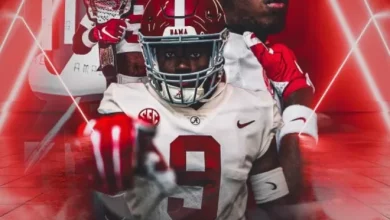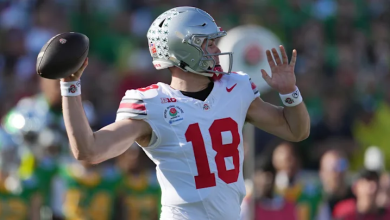Urban Meyer sounds the alarms, warning college football is spiraling amid NIL chaos, portal overload, and lack of leadership or regulation.

When Urban Meyer speaks, the college football world listens. Whether loved, loathed, or somewhere in between, the three-time national champion has long been one of the most vocal—and insightful—voices in the sport. And now, in 2025, as the game enters perhaps its most volatile era, Meyer isn’t holding back.
During a recent appearance on a national platform, Meyer offered a blunt assessment: “College football is spiraling.” His critique wasn’t aimed at one program, player, or policy—it was a system-wide warning. In Meyer’s eyes, the landscape has become unrecognizable, unregulated, and on a dangerous path toward long-term damage.
The Heart of the Chaos: NIL and the Portal
At the center of Meyer’s concern are the two most disruptive forces in modern college football: Name, Image, and Likeness (NIL) and the transfer portal.
When the NIL era launched in 2021, it was hailed as a long-overdue victory for player empowerment. Athletes could finally profit from their own brand. But what was originally intended to be a tool for fair compensation has, in Meyer’s view, become a free-for-all bidding war—one that often ignores values like development, loyalty, and education.
“What we have now isn’t NIL,” Meyer said. “It’s flat-out pay-for-play. Schools are making promises, deals are getting bigger, and no one’s asking how this helps the game long-term.”
Couple that with the transfer portal, which now allows players to switch schools with increasing ease and without penalty, and Meyer sees a perfect storm: young athletes being lured by quick money and immediate playing time, often at the cost of stability, relationships, and growth.
The Impact on Coaches and Culture
As a former coach, Meyer is quick to point out how this new era affects leadership. Recruiting no longer ends when a player signs a letter of intent—it never ends. Every day, every practice, every depth chart shuffle is now a retention battle.
“You used to build a player over three, four years,” Meyer explained. “Now, if a kid isn’t starting by Week 4, he’s in the portal with three offers and a six-figure NIL pitch.”
The strain on locker rooms is real. Meyer warns that trust, unity, and accountability—core pillars of any successful team—are eroding.
“There’s no time to build culture. You’re building a roster every four months. That’s not college football. That’s chaos.”
Is Anyone in Charge?
Perhaps Meyer’s most scathing critique is directed not at the athletes or the coaches, but at the lack of leadership at the national level.
With no centralized body governing NIL, enforcing rules, or establishing fair guidelines across conferences, college football has become a patchwork of state laws, donor groups, and school-by-school interpretations. The NCAA, once the sport’s ultimate authority, has all but abdicated control.
“Right now, the players are leading, the collectives are calling shots, and the NCAA is silent,” Meyer said. “That’s not sustainable.”
In his view, the sport needs a governing commissioner—someone with power and perspective, capable of crafting a consistent national policy and holding programs accountable. Without it, Meyer fears the sport could fracture completely, especially with looming conversations around unionization and athlete employment status.
The Human Cost: Players Lost in the Shuffle
While Meyer acknowledges that many players benefit financially from NIL, he’s deeply concerned about those who don’t.
“Not every kid is making six figures,” he said. “For every headline about a big NIL deal, there are ten kids transferring, getting no offers, and ending up with no degree, no team, and no plan.”
According to recent data, thousands of players enter the portal each year, but many fail to land at a new program. These athletes often give up scholarships or leave programs without fully considering the long-term impact.
Meyer believes this lack of guidance—combined with predatory promises from third-party agents and boosters—is failing a generation of student-athletes.
“These are 18, 19-year-old kids. And too many are being used, sold dreams, then left behind when things don’t pan out.”
Where It’s Working—and Why
Still, Meyer isn’t all doom and gloom. He points to a few programs—Michigan, Georgia, Washington under DeBoer, and even Texas—where NIL and portal strategies are being balanced with strong cultures and academic accountability.
“The best programs still coach, still develop, still teach,” he said. “They’re not just flipping players like they’re in the NFL Draft.”
He applauds schools that set clear NIL parameters, integrate players into community-building roles, and keep education front and center. But he warns that those are the exceptions, not the rule.
“Unless the system changes, the bottom’s going to fall out for a lot of these kids and programs.”
The Clock Is Ticking
For Meyer, the urgency couldn’t be higher. With conference realignment, the expanding College Football Playoff, and more legal challenges to the NCAA’s authority, the next 12–18 months may determine whether college football can stabilize—or splinter.
“We’re at a crossroads,” he said. “And if the people at the top don’t act soon, we’ll look back at this as the moment it all fell apart.”
His proposed solutions?
- National NIL standardization — with contracts, oversight, and limits on inducements.
- Transfer window limits — to prevent in-season tampering and mass movement.
- Leadership — an empowered commissioner with real teeth.
- Mandatory education programs — to prepare athletes for financial and life decisions beyond football.
Final Thoughts: The Love for the Game
Despite his frustration, Urban Meyer’s love for college football hasn’t dimmed. He still sees the magic—in the walk-ons, the game-day atmospheres, the rivalries, and the lifelong relationships.
“This is the greatest sport in the world,” he said. “But it’s slipping away from what made it great—commitment, team-first mentality, and the idea that the journey matters as much as the destination.”
As the 2025 season approaches, Meyer’s warnings should echo in every boardroom, locker room, and collective meeting. Because if the sport’s foundation continues to erode, not even the richest NIL deal or biggest transfer splash will save it.
“Players deserve to get paid. Coaches need to adapt. Fans deserve a game they can still believe in,” Meyer said. “But someone has to lead. And they better do it fast.”









